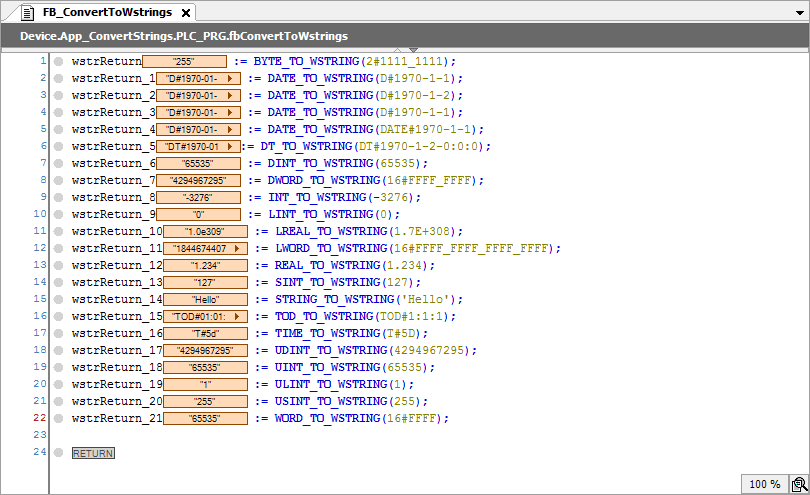



NOTICE

If the operand value for a type conversion operator is outside of the value range
of the target data type, then the result output depends on the processor type and
is therefore undefined. This is the case, for example, when a negative operand value
is converted from LREAL to the target data type UINT.
Information can be lost when converting from larger data types to smaller data types.
The operators convert a date and time value into the specified data type and return a type-converted value.
Call syntax
<variable name> := <date and time conversion operator> ( <operand> ); <operand> = <variable name> | <literal>
The data types DATE and DT use the same memory format internally and are stored as DWORD. The resolution for DATE is 1 day. The resolution for DT is 1 second. Both begin at January 1, 1970.TOD is stored as DWORD with a resolution of 1 millisecond.
Operators
DATE_TO___UXINT DATE_TO___XINT DATE_TO___XWORD DATE_TO_BIT DATE_TO_BOOL DATE_TO_BYTE DATE_TO_DINT DATE_TO_DT DATE_TO_DWORD DATE_TO_INT DATE_TO_LINT DATE_TO_LREAL DATE_TO_LTIME DATE_TO_LWORD DATE_TO_REAL DATE_TO_SINT DATE_TO_STRING DATE_TO_TIME DATE_TO_TOD DATE_TO_UDINT DATE_TO_UINT DATE_TO_ULINT DATE_TO_USINT DATE_TO_WORD DATE_TO_WSTRING DT_TO___UXINT DT_TO___XINT DT_TO___XWORD DT_TO_BIT DT_TO_BOOL DT_TO_BYTE DT_TO_DATE DT_TO_DINT DT_TO_DWORD DT_TO_INT DT_TO_LINT DT_TO_LREAL DT_TO_LTIME DT_TO_LWORD DT_TO_REAL DT_TO_SINT DT_TO_STRING DT_TO_TIME DT_TO_TOD DT_TO_UDINT DT_TO_UINT DT_TO_ULINT DT_TO_USINT DT_TO_WORD DT_TO_WSTRING TOD_TO___UXINT TOD_TO___XINT TOD_TO___XWORD TOD_TO_BOOL TOD_TO_BIT TOD_TO_BYTE TOD_TO_DATE TOD_TO_DINT TOD_TO_DT TOD_TO_DWORD TOD_TO_INT TOD_TO_LINT TOD_TO_LREAL TOD_TO_LTIME TOD_TO_LWORD TOD_TO_REAL TOD_TO_SINT TOD_TO_STRING TOD_TO_TIME TOD_TO_UDINT TOD_TO_UINT TOD_TO_ULINT TOD_TO_USINT TOD_TO_WORD TOD_TO_WSTRING
Long operators
LDATE_TO___UXINT LDATE_TO___XINT LDATE_TO___XWORD LDATE_TO_BIT LDATE_TO_BOOL LDATE_TO_BYTE LDATE_TO_DATE LDATE_TO_DINT LDATE_TO_DT LDATE_TO_DWORD LDATE_TO_INT LDATE_TO_LDT LDATE_TO_LINT LDATE_TO_LREAL LDATE_TO_LTIME LDATE_TO_LTOD LDATE_TO_LWORD LDATE_TO_REAL LDATE_TO_SINT LDATE_TO_STRING LDATE_TO_TIME LDATE_TO_TOD LDATE_TO_UDINT LDATE_TO_UINT LDATE_TO_ULINT LDATE_TO_USINT LDATE_TO_WORD LDATE_TO_WSTRING LDT_TO___UXINT LDT_TO___XINT LDT_TO___XWORD LDT_TO_BIT LDT_TO_BOOL LDT_TO_BYTE LDT_TO_DATE LDT_TO_DINT LDT_TO_DWORD LDT_TO_INT LDT_TO_LDATE LDT_TO_LINT LDT_TO_LREAL LDT_TO_LTIME LDT_TO_LTOD LDT_TO_LWORD LDT_TO_REAL LDT_TO_SINT LDT_TO_STRING LDT_TO_TIME LDT_TO_TOD LDT_TO_UDINT LDT_TO_UINT LDT_TO_ULINT LDT_TO_USINT LDT_TO_WORD LDT_TO_WSTRING LTOD_TO___UXINT LTOD_TO___XINT LTOD_TO___XWORD LTOD_TO_BOOL LTOD_TO_BIT LTOD_TO_BYTE LTOD_TO_DATE LTOD_TO_DINT LTOD_TO_DT LTOD_TO_DWORD LTOD_TO_INT LTOD_TO_LDATE LTOD_TO_LDT LTOD_TO_LINT LTOD_TO_LREAL LTOD_TO_LTIME LTOD_TO_LWORD LTOD_TO_REAL LTOD_TO_SINT LTOD_TO_STRING LTOD_TO_TIME LTOD_TO_UDINT LTOD_TO_UINT LTOD_TO_ULINT LTOD_TO_USINT LTOD_TO_WORD LTOD_TO_WSTRING
Converting to a Boolean value
The operator returns FALSE if and only if the operand value can be interpreted as "0".
|
|
|
|
|
|
|
|
|
|
|
|
|
|
|
|
|
|
Converting to an integer
The data types DATE and DT use the same memory format internally, namely a DWORD. The resolution for DATE is 1 day. The resolution for DT is 1 second. Both begin at January 1, 1970.
TOD is stored as DWORD with a resolution of 1 millisecond.
|
|
|
|
|
|
|
|
|
|
|
|
|
|
|
|
|
|
|
|
|
|
|
|
Converting to a string




NOTICE

String manipulation when converting to STRING or WSTRING
When converting the type to STRING or WSTRING, the typed value is left-aligned as a character string and truncated if it is too
long. Therefore, declare the return variable for the type conversion operators <>_TO_STRING and <>_TO_WSTRING long enough that the character string has enough space without any manipulation.
The operands of type DATE, DATE_AND_TIME, TIME_OF_DAY, DT, or TOD, which are passed to an operator for a data and time conversion, are converted to
their constant syntax (literal syntax). The generated string contains the keyword
D#, DT# or TOD# and then the size with its data and time unit, as indicated in the IEC 61131-3 specification.
Examples

Examples
FBD implementation language
The controller is in online mode in order to monitor the variables.







